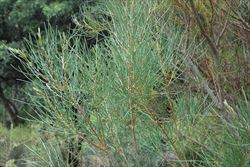Click on images to enlarge

habit (Photo: Rob and Fiona Richardson)

older stems (Photo: Rob and Fiona Richardson)

younger stems and needle-like leaves (Photo: Rob and Fiona Richardson)
Scientific Name
Hakea drupacea (C.F. Gaertn.) Roem. & Schult.
Synonyms
Conchium drupaceum C.F. Gaertn.Hakea gibbosa (Sm.) Cav. (misapplied)Hakea lambertii SweetHakea pectinata Dum. Cours.Hakea suaveolens R. Br.
Family
Proteaceae
Common Names
fork leaved hakea, fork-leaved hakea, scented hakea, sweet hakea, sweet-scented hakea
Origin
Native to the coastal and sub-coastal districts of southern Western Australia (i.e. from Albany to Point Malcolm).
Naturalised Distribution
Naturalised in southern Victoria and in south-eastern South Australia. Possibly also naturalised beyond its native range in Western Australia.
Naturalised overseas in southern Africa and New Zealand.
Notes
Sweet hakea (Hakea drupacea) is regarded as an environmental weed in Victoria and as a "sleeper weed" in some other parts of southern Australia. It can rapidly invade native areas, especially in coastal situations, and regenerates prolifically after burning. Its seeds are also stimulated to germinate by heat, and seedlings can be found in very high numbers after fires. Dense sweet hakea (Hakea drupacea) infestations eventually smother indigenous vegetation and prevent the regeneration of locally native species.
At present, this garden escape is mainly causing problems along the southern coast of Victoria and it appears on numerous local environmental weed lists in this region (i.e. in Monash City, Hume City, Monash City, Frankston City, Colac Otway Shire and Surf Coast Shire Councils, in the Geelong region, and on the Mornington Peninsula). It is also becoming naturalised in coastal areas in south-eastern South Australia (i.e. in the South-East and Southern Lofty Mountains regions) and is regarded as being a moderately invasive weed in fynbos vegetation in South Africa.

